
A nickel is a five-cent coin struck by the United States Mint. Composed of cupronickel, the piece has been issued since 1866. Its diameter is 0.835 inches (21.21 mm) and its thickness is 0.077 inches (1.95 mm).
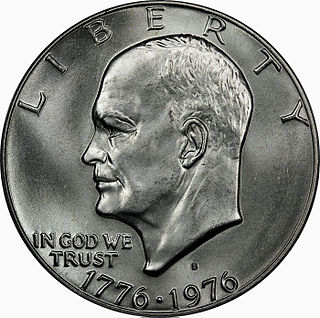
The United States Bicentennial coinage is a set of circulating commemorative coins, consisting of a quarter, half dollar and dollar struck by the United States Mint in 1975 and 1976. Regardless of when struck, each coin bears the double date 1776–1976 on the normal obverses for the Washington quarter, Kennedy half dollar and Eisenhower dollar. No coins dated 1975 of any of the three denominations were minted.

The Morgan dollar is a United States dollar coin minted from 1878 to 1904, in 1921, and beginning again in 2021 as a collectible. It was the first standard silver dollar minted since the passage of the Coinage Act of 1873, which ended the free coining of silver and the production of the previous design, the Seated Liberty dollar. It contained 412.5 Troy grains of 90% pure silver. The coin is named after its designer, United States Mint Assistant Engraver George T. Morgan. The obverse depicts a profile portrait representing Liberty, modeled by Anna Willess Williams, while the reverse depicts an eagle with wings outstretched. The mint mark, if present, appears on the reverse above between D and O in "Dollar".

The Seated Liberty dollar was a dollar coin struck by the United States Mint from 1840 to 1873 and designed by its chief engraver, Christian Gobrecht. It was the last silver coin of that denomination to be struck before passage of the Coinage Act of 1873, which temporarily ended production of the silver dollar for American commerce. The coin's obverse is based on that of the Gobrecht dollar, which had been minted experimentally from 1836 to 1839. However, the soaring eagle used on the reverse of the Gobrecht dollar was not used; instead, the United States Mint (Mint) used a heraldic eagle, based on a design by late Mint Chief Engraver John Reich first utilized on coins in 1807.

The Walking Liberty half dollar is a silver 50-cent piece or half dollar coin that was issued by the United States Mint from 1916 to 1947; it was designed by Adolph A. Weinman, a well-known sculptor and engraver.
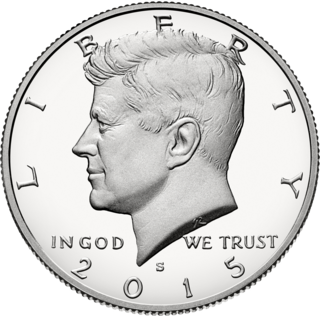
The Kennedy half dollar, first minted in 1964, is a fifty-cent coin issued by the United States Mint. Intended as a memorial to the assassinated 35th president of the United States John F. Kennedy, it was authorized by Congress just over a month after his death. Use of existing works by Mint sculptors Gilroy Roberts and Frank Gasparro allowed dies to be prepared quickly, and striking of the new coins began in January 1964.

The Standing Liberty quarter is a 25-cent coin that was struck by the United States Mint from 1916 to 1930. It succeeded the Barber quarter, which had been minted since 1892. Featuring the goddess of Liberty on one side and an eagle in flight on the other, the coin was designed by American sculptor Hermon Atkins MacNeil.
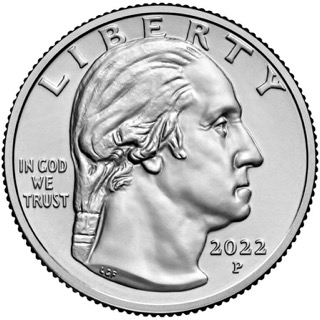
The Washington quarter is the present quarter dollar or 25-cent piece issued by the United States Mint. The coin was first struck in 1932; the original version was designed by sculptor John Flanagan.

The New Rochelle 250th Anniversary half dollar is a commemorative coin struck by the United States Bureau of the Mint to mark the 250th anniversary of the settling of New Rochelle in Westchester County, New York. Artist Gertrude K. Lathrop designed the piece; she was chosen after work by Lorrilard Wise was rejected by the federal Commission of Fine Arts (CFA). The coin depicts a fatted calf on one side, being led by John Pell, who sold the land on which New Rochelle now stands; the other shows a fleur de lis, an element of the city seal of New Rochelle and of France's La Rochelle, its eponym. The piece is dated 1938 but was minted the previous year. The New Rochelle piece was the last new-design commemorative struck by the Mint until 1946.

The United States Sesquicentennial coin issue consisted of a commemorative half dollar and quarter eagle struck in 1926 at the Philadelphia Mint for the 150th anniversary of American independence. The obverse of the half dollar features portraits of the first president, George Washington, and the president in 1926, Calvin Coolidge, making it the only American coin to depict a president in his lifetime.

The five Panama–Pacific commemorative coins were produced in connection with the 1915 Panama–Pacific International Exposition in San Francisco. Struck at that city's mint, the issue included round and octagonal $50 pieces. Excepting modern bullion coins, these two gold pieces are the highest denomination ever issued and the largest coins ever struck by the United States Mint. The octagonal $50 piece is the only U.S. coin to be issued that is not round.

The Pilgrim Tercentenary half dollar or Pilgrim half dollar was a commemorative fifty-cent coin struck by the United States Bureau of the Mint in 1920 and 1921 to mark the 300th anniversary (tercentenary) of the arrival of the Pilgrims in North America. It was designed by Cyrus E. Dallin.

The Maine Centennial half dollar is a commemorative coin struck in 1920 by the United States Bureau of the Mint, in honor of the anniversary of Maine's admission to the Union on March 15, 1820. It was sculpted by Anthony de Francisci, following sketches by artist Harry Cochrane, from Monmouth, Maine.

The Missouri Centennial half dollar is a commemorative fifty-cent piece struck by the United States Mint in 1921. It was designed by Robert Ingersoll Aitken. The US state of Missouri wanted a commemorative coin to mark its centennial that year. Legislation for such a coin passed through Congress without opposition and was signed by President Warren G. Harding on his inauguration day, March 4, 1921. The federal Commission of Fine Arts hired Aitken to design the coin, which depicted Daniel Boone on both sides. The reverse design, showing Boone with a Native American, has been interpreted as symbolizing the displacement of the Indians by white settlers.

The Hudson, New York, Sesquicentennial half dollar, sometimes called the Hudson Sesquicentennial half dollar, is a commemorative fifty-cent piece struck by the United States Bureau of the Mint in 1935. The coin was designed by Chester Beach. Its obverse depicts the Half Moon, flagship of Henry Hudson, after whom the city of Hudson, New York is named. In addition to showing the ship, the coin displays a version of the Hudson city seal, with Neptune riding a whale, a design that has drawn commentary over the years.
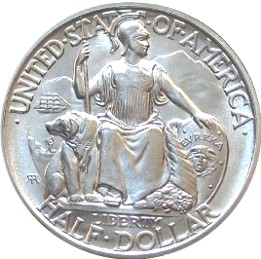
The California Pacific International Exposition half dollar, sometimes called the California Pacific half dollar or the San Diego half dollar, is a commemorative fifty-cent piece struck by the United States Bureau of the Mint in 1935 and 1936. Robert Ingersoll Aitken designed the coin. Its obverse depicts Minerva and other elements of the Seal of California; the reverse shows buildings from the California Pacific International Exposition, which the coin was issued to honor.

The York County, Maine, Tercentenary half dollar is a 50-cent commemorative coin minted in 1936 to mark the tercentenary of the founding of York County, Maine. The obverse shows Brown's Garrison, the fort around which York County was formed, while the reverse depicts the county's arms.

The Norfolk, Virginia, Bicentennial half dollar is a half dollar commemorative coin struck by the United States Bureau of the Mint in 1937, though it bears the date 1936. The coin commemorates the 200th anniversary of Norfolk being designated as a royal borough, and the 100th anniversary of it becoming a city. It was designed by spouses William Marks Simpson and Marjory Emory Simpson.
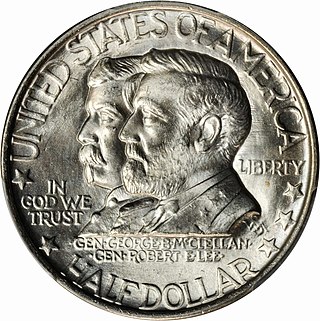
The Battle of Antietam half dollar was designed by William M. Simpson and minted in 1937 to commemorate the 75th anniversary of the Battle of Antietam. The obverse depicts Robert E. Lee and George McClellan, and the reverse shows Burnside's Bridge.

The Roanoke Island, North Carolina, half dollar is a commemorative coin issued by the United States Bureau of the Mint in 1937. The coin commemorated the 350th anniversary of the Roanoke Colony, depicting Sir Walter Raleigh on one side, and on the other Eleanor Dare, holding her child, Virginia Dare, the first child of English descent born in an English colony in the Americas.























